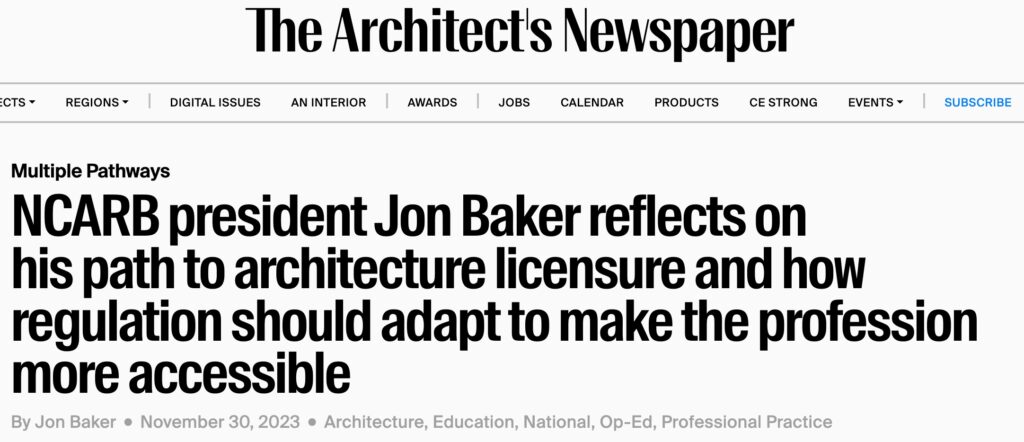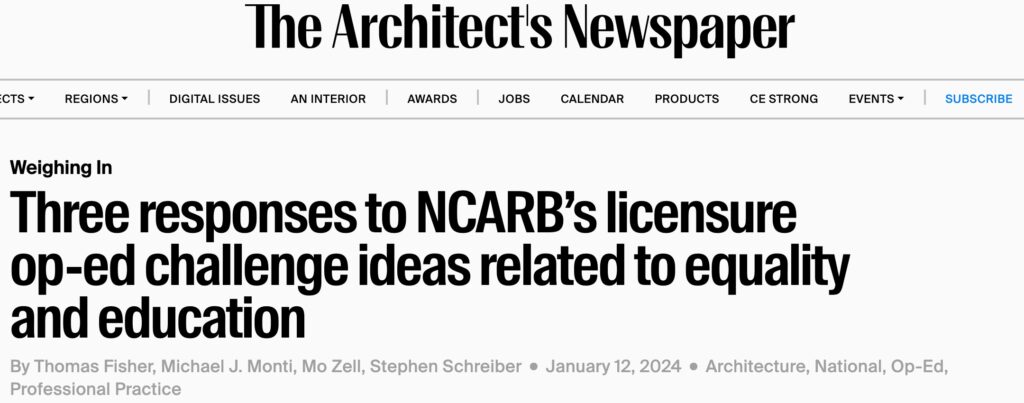MULTIPLE PATHWAYS TO LICENSURE
Recently, we came across the following set of articles in response to a NCARB Op-Ed posted last fall. But, before you read the three responses, you need to read the original NCARB Statement.
Below is a link to the Pathways to Practice NCARB Statement as adopted by the NCARB Board of Directors. As you will read, it is their call to action and a recognition of their essential role as a thought leader regarding the evolution of architectural licensure.
Pathways to Practice NCARB Statement endorsing multiple paths to licensure.
- NCARB encourages all its licensing jurisdiction members to explore the concept of “many paths/one goal” for both initial and reciprocal licensure by recognizing multiple combinations of experience and examination, with or without various iterations of higher education, as sufficient qualifiers. This augments the traditional path involving accredited education.
If you read the attached commentary, the reason for pursuing the multiple paths is to allow greater access to the profession. NCARB thinks the current barriers to an architectural education, namely, cost, and other impediments are preventing underrepresented individuals from becoming an architect. And the Pathways to Practice NCARB Statement will address it.
One effort NCARB is the call for a feasibility study for a 4-year accredited degree option instead of five years, since NAAB core requirements could be feasibly delivered within a 4-year time frame.
What do you think? Can someone with a desire to become an architect gain the necessary knowledge as currently required by NAAB in just four years?

To better understand, read the Op-Ed from the NCARB President Jon Baker and his individual path to becoming an architect. As he states,
“I do not have a college degree, but I have been a licensed architect for over 40 years.” – Jon Baker, NCARB President
NCARB President Jon Baker reflects architecture licensure regulation profession more accessible.
He continues, “The National Council of Architectural Registration Boards (NCARB) recently released a statement endorsing multiple pathways to licensure. As the FY24 NCARB President, my biggest priority is to support this effort and increase the number of jurisdictions that provide multiple pathways to becoming an architect, thereby increasing access to licensure for groups traditionally left behind.”
From reading his essay, increasing diversity for those pursuing licensure is a primary motivation, but the solution seems to be creating an accredited four-year degree.
But, now read the response from three essays by those in architectural education, namely, Thomas Fisher (professor at U Minnesota), Michael J. Monti (executive director of ACSA), Mo Zell (president of ACSA and interim dean of U Wisconsin-Milwaukee), and Stephen Schreiber (president of NAAB).

Three responses NCARB OP-ED licensure equality education
https://www.archpaper.com/2024/01/three-responses-ncarb-op-ed-licensure-equality-education/
Fisher starts with the title of his essay – Will NCARB destroy the architectural profession? He continues:
“This is not about equity, but about economics. It would ensure that the architectural profession has a highly dependent and lowly paid labor pool from which it can extract as much value as possible at the least cost.”
We will let you read the rest of his essay.
The next essay by Monti and Zell continues the critique of the proposal —
“However, we also believe that reducing or eliminating education is a misleading and potentially harmful path for future architects and for the profession as a whole.”
They continue – “A path to licensure that does not include a professional degree will not be shorter.” In other words, a four-year accredited degree would include a longer experience requirement.
And, finally, there is a third essay by Stephen Schreiber, the current NAAB President.
So, what does this discussion mean and why should you care? It is our opinion that if you are in the architectural profession you should care. And you should take the time to know of potential changes in architectural education. With that said, what are your thoughts and opinions.
Without giving too much away, we would want a great deal more information from NCARB and their plan for a four-year accredited architecture degree before supporting such a change. What is ironic is that NCARB is not in the business of architectural education. Who is? NAAB and ACSA. As such, why are they not leading the charge?
Best!
